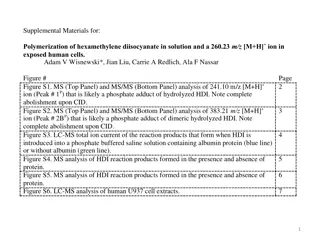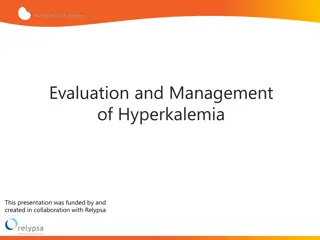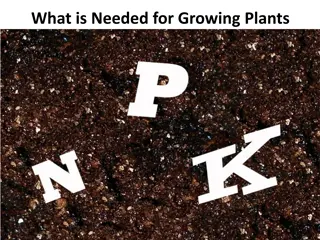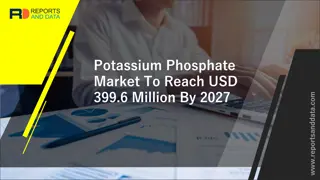Titration Colour Changes
This collection features various experiments in chemistry involving titration and solutions. It includes procedures such as standardizing hydrochloric acid using sodium carbonate, titrating hydrochloric acid with sodium hydroxide to produce sodium chloride, determining the concentration of ethanoic
0 views • 10 slides
Global biofertilizer market- Emerging trends and opportunities
The global biofertilizers market is segmented by microorganism type (nitrogen-fixing microbes, phosphate solubilizing & mobilizing microbes, potassium solubilizing & mobilizing microbes, other microorganism types), crop type (cereals & grains, oilseeds & pulses, fruits & vegetables, other crop types
1 views • 4 slides
Electrolyte and Metabolic Disturbances in the Critically Ill
Dr. Srilekha Ammapalli discusses the cations (sodium, potassium, calcium, magnesium) and anions (chloride, bicarbonate, phosphate, lactate) involved in electrolyte and metabolic disturbances in critically ill patients. The physiology, causes of abnormalities, diagnosis, evaluation, and management of
2 views • 104 slides
Nucleic Acids Overview
Delve into the intricate world of nucleic acids with a focus on DNA and RNA structures, DNA replication, RNA transcription, protein biosynthesis, cancer/chemotherapy, genetic engineering, and more. Explore the structures of bases, sugars, nucleosides, nucleotides, and parts of nucleotides, along wit
8 views • 58 slides
Understanding the Role of Phosphatase Enzymes in Metabolic Reactions
Phosphatase enzymes play a crucial role in various metabolic processes by releasing phosphate groups, increasing their availability for energy synthesis and cell structure formation. Acid phosphatases, with an optimum pH below 7.0, can be extracted from plant tissues like germinating mung beans. A p
7 views • 34 slides
Paediatric Patients with Kidney Failure Requiring Replacement Therapy - ANZDATA Registry Insights
Explore the latest data and graphs from the ANZDATA Registry's 46th Annual Report regarding paediatric patients with kidney failure requiring replacement therapy. Discover trends in incidence, prevalence, educational participation, body mass index, hemoglobin levels, use of erythropoietic agents, fe
2 views • 35 slides
Bone Fractures
Bone fractures can occur due to external forces, high-energy trauma, bone fatigue, or underlying skeletal diseases. Symptoms include pain, tenderness, swelling, and difficulty moving. Different types of fractures include nondisplaced, displaced, compound, pathological, longitudinal, and spiral fract
0 views • 15 slides
Global Iron Phosphate Market
The Global Iron Phosphate Market Size is Anticipated to Exceed USD 868.5 Million by 2033, Growing at a CAGR of 5.10% from 2023 to 2033.\n\n
0 views • 5 slides
Understanding Hypokalemia and Potassium Regulation
Hypokalemia is a condition characterized by low potassium levels, crucial for intracellular functions. The Na+/K+ ATPase pump maintains the ICF/ECF gradient. Potassium excretion occurs mainly via the kidneys, with minimal variation in proximal tubule reabsorption. The collecting duct plays a vital r
0 views • 50 slides
Understanding Animal Genetics: A Comprehensive Overview
Animal genetics is the study of heredity, inheritance of traits from parents to offspring, genetic material like DNA, chromosomes, genes, alleles, and nucleotides. It involves the understanding of chromosomes in different livestock species, DNA as the carrier of genetic information, genes as units o
0 views • 67 slides
Amino Acid Catabolism: Pathways and Reactions
Amino acid catabolism involves removing amino groups via deamination, leading to urea synthesis and TCA cycle intermediates. The process includes transamination and oxidative deamination reactions, with specific aminotransferases catalyzing these reactions. Transamination is a key step in funneling
0 views • 23 slides
Chemfos 700/710 Vxx Zinc Phosphate with Versa Bond Rinse Conditioner
Chemfos 700/710 Vxx Zinc Phosphate with Versa Bond Rinse Conditioner is a zinc phosphate-based surface conditioning material used in the water rinse before the zinc phosphate stage. It acts as a nucleating agent for superior crystal refinement, offering benefits like sludge reduction, compatibility
0 views • 4 slides
Understanding the Urea Cycle in Biochemistry
Explore the intricate process of the urea cycle, its role in removing amino groups from amino acids, converting ammonia into urea in the liver, and managing hyperammonemia. Learn about transamination, oxidative deamination, and the importance of glutamine and alanine in ammonia transport. Discover t
1 views • 26 slides
Understanding Glycogenolysis in Vertebrates: A Detailed Overview
In vertebrates, glycogen serves as a glucose reservoir in the liver and skeletal muscles. Glycogenolysis is the breakdown of glycogen into glucose-6-phosphate, crucial for providing glucose to tissues in the absence of dietary sources. Enzymes like glycogen phosphorylase, debranching enzyme, and pho
0 views • 13 slides
Insights into Enzymes in Genetic Engineering
Discover the role of enzymes like Polynucleotide Phosphorylase, Deoxyribonuclease, and Phosphatase in genetic engineering processes. Learn how these enzymes regulate mRNA processing, DNA cleavage, and phosphate group cleavage, crucial for various applications in biotechnology.
0 views • 13 slides
Understanding Chemical Groups and Macromolecules in Biological Processes
In biological processes, certain chemical groups play crucial roles in molecular functions. These functional groups, including hydroxyl, carbonyl, carboxyl, amino, sulfhydryl, phosphate, and methyl, are essential for the structure and function of biological molecules. Additionally, macromolecules, s
0 views • 9 slides
Harnessing Phosphate-Solubilizing Microorganisms for Sustainable Crop Growth
Phosphorus is crucial for plant growth, but its availability is often limited due to insoluble forms in soil. The use of phosphate-solubilizing microorganisms (PSMs) can help convert insoluble phosphorus into a usable form for plants. This process involves isolating, screening, and mass-producing PS
0 views • 6 slides
Enhancing Compost Quality for Organic Farming: Phosphorous-Enriched Compost Preparation
Composting is a natural process crucial for organic farming. Enriched compost improves nutrient supply to crops. Learn how to prepare phosphorous-enriched compost using organic wastes, bio-inoculants, and rock phosphate. Follow a method involving layering organic materials, cow dung, and rock phosph
3 views • 8 slides
The Intriguing Structure and Functions of DNA
DNA, or Deoxyribonucleic Acid, is a fundamental molecule in living organisms, characterized by its double helical structure consisting of two antiparallel polynucleotide chains. Each strand is composed of nucleotide monomers, comprising deoxyribose sugar, phosphate group, and nitrogenous bases (puri
0 views • 12 slides
Understanding Transamination and Deamination in Biochemistry
Transamination is a vital chemical reaction in biochemistry that transfers amino groups to ketoacids to form new amino acids, playing a crucial role in amino acid metabolism. Enzymes called transaminases facilitate this process, utilizing -ketoglutarate as a key amino group acceptor. The mechanism i
5 views • 17 slides
Redox Titration: Potassium Permanganate with Iron(II) Salt Assay
Ferrous sulfate (FeSO4.7H2O) is used in medical treatments for iron deficiency. This article discusses the redox titration process involving potassium permanganate and ferrous sulfate, along with the chemical principles, procedure, and calculations involved. Potassium permanganate is a powerful oxid
5 views • 7 slides
Polymerization of Hexamethylene Diisocyanate in Solution and Its Impact on Human Cells
This study investigates the polymerization of hexamethylene diisocyanate (HDI) in solution and its interaction with exposed human cells. Multiple mass spectrometry analyses reveal the formation of phosphate adducts of hydrolyzed HDI, dimeric hydrolyzed HDI, and reaction products in the presence or a
0 views • 7 slides
Understanding Geometrical Isomers in Potassium Chromate Complexes
Explore the preparation methods, crystal shapes, and properties of cis and trans isomers of potassium chromate complexes. Learn about the use of oxalic acid and potassium dichromate, compare the two isomers, and understand the oxidation and reduction reactions involved.
3 views • 8 slides
Understanding Rocks: Types, Formation, and Properties
Rocks can be classified as metamorphic, igneous, or sedimentary based on their formation processes. Florida's phosphate deposits and pumice formation showcase the diversity of rocks. A scientist's rock cycle model helps predict changes, while pressure on sediments leads to new rock formation. Basalt
1 views • 22 slides
Understanding Marine Phosphate Mining in Namibia: EIA Process, Findings, and Decision-Making
Explore the complexities surrounding marine phosphate mining in Namibia, focusing on the Environmental Impact Assessment (EIA) process, key findings, and the challenges in reaching a sound decision. Delve into the global overview of seabed mining, the significance of EIA, and the broader recommendat
0 views • 32 slides
The Intricate Pathways of Choline Synthesis and Oxidation in Molecular Biology
Delve into the complex processes of choline synthesis and oxidation pathways, involving the integration of hydride ions and various molecules, essential for the production of phosphatidylcholine and other crucial compounds in biological systems. Learn about the enzymes and mechanisms that drive the
1 views • 11 slides
Evaluation of Resistant Hypertension and Hypokalemia in a Young Female
A 38-year-old female with a history of resistant hypertension and hypokalemia was referred for evaluation. She had been on multiple antihypertensive medications but still had uncontrolled blood pressure and low potassium levels. After treatment with potassium supplementation and adjustment of medica
0 views • 50 slides
Understanding Dental Cements and Temporary Filling Materials
Dental cements are essential in dentistry, acting as barriers against various stimuli and irritants. They can be classified based on different compounds and have specific applications such as root canal sealers and orthodontic bonding. Zinc phosphate cement is a common material used for lining, whil
0 views • 24 slides
Understanding Hyperkalemia: Causes, Evaluation, and Management
Hyperkalemia is a condition characterized by elevated serum potassium levels, posing serious risks such as cardiac arrhythmias and sudden death. Pathogenesis involves factors like abnormal potassium release, impaired distribution, and excretory process impairment. Causes range from pseudohyperkalemi
0 views • 35 slides
Inorganic Chemistry Practical II: Preparation and Properties of Potassium Alum
This practical guide covers the preparation and properties of potassium alum, a versatile chemical compound used in various industries. Learn about its crystal structure, uses, and methods of preparation through detailed experiments and analysis.
0 views • 8 slides
Understanding G6PD Deficiency Hemolytic Anemia: Biochemical Basis and Implications
G6PD deficiency hemolytic anemia is an inherited condition characterized by reduced levels of glucose-6-phosphate dehydrogenase (G6PD), leading to impaired production of NADPH. This deficiency affects the Pentose Phosphate Pathway (PPP) and can result in oxidative stress, causing damage to DNA, prot
0 views • 18 slides
Understanding the Pentose Phosphate Pathway in Metabolism
The Pentose Phosphate Pathway, also known as the Hexose Monophosphate shunt, is an alternative route for glucose metabolism that plays a crucial role in NADPH synthesis, fatty acid production, antioxidant activity, and nucleotide formation. This pathway involves oxidative and non-oxidative phases, r
0 views • 12 slides
Understanding Photosynthesis and Photophosphorylation Processes
Photosynthesis is a vital process where autotrophic organisms trap solar energy to convert it into chemical energy in the form of food. Non-cyclic photophosphorylation involves the transfer of phosphate groups and ATP synthesis utilizing light energy. This process takes place at photosystem II in ch
0 views • 10 slides
Understanding DNA Structure and Denaturation Process
DNA is a double helical structure made of 2 antiparallel polynucleotide chains with nucleotide monomers. The structure contains deoxyribose sugar, phosphate groups, and nitrogenous bases (purines and pyrimidines). Hydrogen bonds between base pairs stabilize the structure. Denaturation can occur due
0 views • 16 slides
Understanding the Structure of DNA
DNA, which stands for Deoxyribonucleic Acid, is a double-stranded molecule composed of nucleotides. Each nucleotide consists of a base, a phosphate, and deoxyribose sugar. These nucleotides bond together to form a sugar-phosphate backbone through chemical bonds. The DNA molecule contains four bases
0 views • 14 slides
Exploring Color Combinations with Chemical Reactions
Explore various color combinations using aqueous solutions of potassium dichromate, copper sulfate, and other colorless solutions. By mixing these solutions, generate distinct colors in test tubes through chemical reactions. Different hues such as yellow, blue, orange, light purple, and green are ac
0 views • 6 slides
Understanding Serum Phosphorus: Importance, Measurement, and Functions
Serum phosphorus, or inorganic phosphate, plays a vital role in maintaining bone health, energy production, muscle function, and overall cellular health. This mineral is found in various foods and is essential for the normal functioning of the kidneys, bones, muscles, and blood vessels. Phosphate le
0 views • 14 slides
Factors Influencing Algae Growth in Water Ecosystems
Nutrients play a crucial role in algae growth, with inorganic nutrients like nitrogen and phosphorus being key factors. Algae require macroelements such as carbon, hydrogen, oxygen, sulfur, potassium, calcium, phosphorus, and nitrogen in large quantities, as well as microelements like iron, manganes
0 views • 16 slides
The Essentials of Plant Nutrition: Nitrogen, Phosphorus, and Potassium
Plants require a balanced diet of nutrients for growth and development. Nitrogen stimulates above-ground growth, phosphorus enhances root growth and flower formation, while potassium promotes fruit development. However, excessive use of fertilizers can lead to environmental issues like algal blooms,
0 views • 6 slides
Global Potassium Phosphate Market Outlook and Key Players
The global potassium phosphate market is projected to reach USD 399.6 million by 2027, driven by a surge in demand for potassium phosphate in food processing and kidney-related applications. Key players in this market include BASF SE, Evonik Industries AG, Baker Hughes Incorporated, and others. Dist
0 views • 4 slides







































